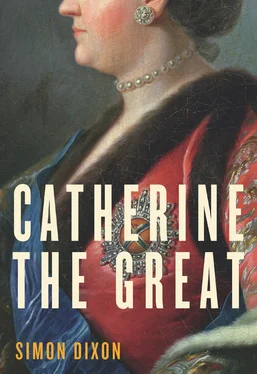Over the following autumn, the Choglokovs sought to limit the potential for temptation by restricting access to Peter and Catherine so severely that it seemed they were virtually under house arrest. Yet such crude attempts to drive the young couple into each other’s arms merely succeeded in feeding their mutual resentments. Far from producing the universally desired heir, Catherine and her husband already seemed to be leading separate lives. During the pilgrimage to the Trinity monastery while the Court was in Moscow in summer 1749, they rarely met except at table and in bed—and ‘he came there after I had fallen asleep and went out before I woke up’. 8
Seeking solace in private reading, Catherine was often to be found with her head in a book. Shortly before the Court returned to St Petersburg at the end of 1744, Count Henning Adolf Gyllenborg, a Swedish nobleman whom she had first met in Hamburg, had flatteringly suggested that she might draft an autobiographical ‘character-sketch of a fifteen-year-old philosophe ’. As models, he recommended Plutarch’s Lives , which she tracked down only later, and the life of Cicero, of which she apparently read no more than a couple of pages in German translation. Neither did she finish Montesquieu’s short treatise On the Causes of the Grandeur and Decline of the Roman Republic (1734): ‘it made me yawn’. 9Even for one so self-consciously ‘studious’, such works were too demanding. Voltaire’s fiction, which she discovered in 1746, was more immediately attractive. Two years later, she had graduated to Brantôme’s lubricious memoirs of the sixteenth-century French Court and Péréfixe’s life of its most celebrated monarch, Henri IV, who was to remain one of her lifelong heroes. Soon more difficult books came within her range. Before tackling Montesquieu’s The Spirit of the Laws (1748), the greatest work of political philosophy of the age on which she would later base her own Instruction to the Legislative Commission, she started in 1751 to read Pierre Bayle’s Historical and Critical Dictionary , a fundamental work of the early Enlightenment. ‘Every six months I finished a volume, and from this, one can imagine in what solitude I spent my life.’ 10
* * *
Withdrawal was only one of Catherine’s strategies for survival. In public she embarked on a concerted campaign to please Elizabeth and her Court, though it was by no means simple to retain the approval of such a volatile monarch. It was particularly fruitless to try to share her developing literary interests with an empress who had inherited her father’s volcanic temper with none of his intellectual curiosity. Although the library at St Petersburg’s Summer Palace contained almost 600 volumes in French, including classic works by Bayle, Michel Montaigne and Hugo Grotius, Elizabeth had them removed to the Academy of Sciences in 1745, when diplomatic relations between St Petersburg and Versailles were damaged by the disgrace of the French ambassador, the Marquis de Chétardie, and their return five years later seems unlikely to have been connected with her personal tastes in reading. 11Indeed, as Catherine soon discovered, ‘there was a whole raft of subjects that she did not like at all. So, for example, one must not speak of the king of Prussia, nor of Voltaire, illness, the dead, beautiful women, French manners or the sciences; all these subjects displeased her.’ 12
There is no need to accept this verdict on Elizabeth’s philistinism at face value. Monarchs are famously difficult to talk to—‘I would rather let people interpret my silence than my words,’ remarked the taciturn Louis XVI 13—and Catherine was understandably cautious about offending the woman whose permission was required every time she wanted to set foot outside the palace. Though there seems little reason to credit the empress with bookish interests, her attitude to death, mocked by Catherine as fearful superstition, was by no means incompatible with rational Enlightened thinking. Nauseated by the smell of corpses on her way to the suburban palace at Yekaterinhof, she ordered more earth to be piled on the graves she could see from her carriage and insisted that future burials be carried out further from the centre of St Petersburg. Still more drastic steps were taken in advance of the Court’s visit to Moscow in 1749, when not only were burials banned at churches between the Kremlin and the Golovin Palace, but existing graves were razed to the ground, the tombstones being donated for new church buildings. 14These were measures which owed something to a growing concern with public hygiene. Meanwhile, Elizabeth had done everything in her power to limit the ‘great and useless expense’ that her leading subjects insisted on lavishing on their funerals. 15Whereas Russian nobles continued to regard an elaborate funeral as the ultimate status symbol, their monarch’s attitude was more in tune with changing sentiments in Western Europe, where ‘grief was becoming more introverted and intense, more private, separated from the formal observances of the corporate hierarchical society’. 16
Elusive though it remained, privacy was highly prized by Elizabeth, who had a metal grille put up around her box at the opera house in St Petersburg. One of the best-known episodes in Catherine’s memoirs describes the empress’s splenetic outburst on discovering that Peter had drilled holes through a door so that he could spy on her meals with Aleksey Razumovsky. 17It was this incident which prompted the reorganisation of the Young Court in 1746. Usually interpreted as evidence of her husband’s incurable infantilism (or, at any rate, of Catherine’s anxiety to highlight it), it tells us just as much about the empress’s yearning to escape the relentless public eye at a Court where the monarch was permanently on display.
Hunting offers another revealing example. Had they known that Louis XV and his entourage had shot more than 1700 partridges on the plain of Saint-Denis on a single day in September 1738, readers of the St Petersburg News might have been less impressed to learn that in the six weeks between 10 July and 26 August 1740, Empress Anna had bagged a total of 488 items: 9 stags, each with between 14 and 24 antlers, 16 wild goats, 4 wild boar, a wolf, 374 hares, 68 wild duck and 16 large seabirds. 18Nevertheless, lists of such achievements were routinely published since success in the field was understood everywhere in Europe as a sign of imperial prowess and international prestige. In September 1751, Elizabeth staged an extravagant hunt at Krasnoye Selo for the Austrian ambassador, who was given one of the best horses from the imperial stables and led by grooms wearing costumes designed expressly for the event at a cost of 20,000 roubles. This hunt took place in the full glare of publicity. Yet when the official press drew attention to the empress’s personal passion for hawking later that autumn, she promptly banned all articles referring to the imperial family without her prior approval. 19
Elizabeth had grown up at the hunting lodge at Tsarskoye Selo and consistently sought to preserve it as a private space. Though it was later to become Catherine’s favourite summer residence, she and Peter were invited there a mere eight times before 1762. Only in 1748 were they in residence with the empress herself, to celebrate Bartolomeo Rastrelli’s first reconstruction of the palace, and even then Elizabeth often dined alone. 20For the most part, she preferred private jaunts with Razumovsky and her friends, during which she could most readily resume her father’s role as ‘the leader of revelry’. 21For one such bacchanalian expedition, the cellarer at Monplaisir brought out 11 half-flasks of ‘Her Majesty’s sweet wine’ (Hungarian Tokay), 21 bottles of her favourite English beer, 12 bottles of fortified wine, 1 bottle of the ‘new sweet wine’, 17 bottles of Burgundy, 16 bottles of champagne, 53 bottles of Rhine wine, 6 flasks of Gdansk vodka, 2 flasks of aniseed-flavour vodka, half a flask of lemon vodka and 2 phials of mustard. 22
Читать дальше












